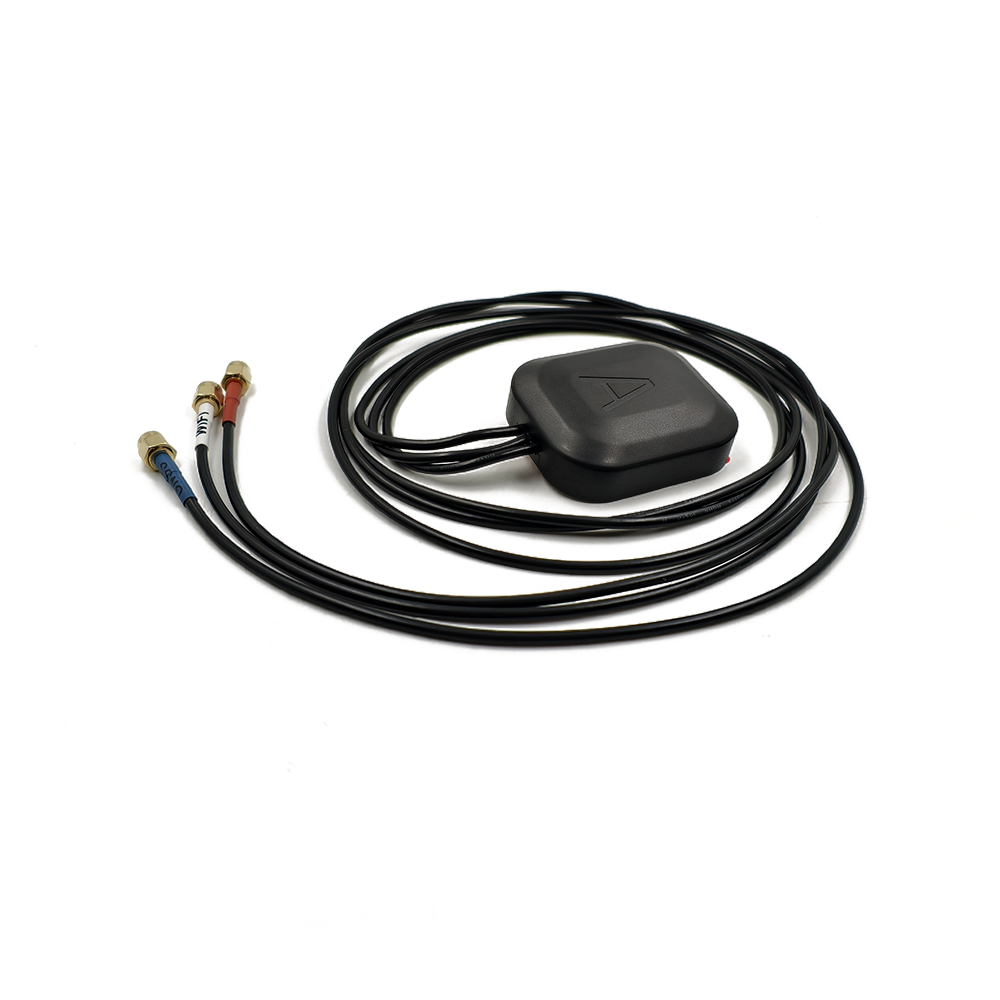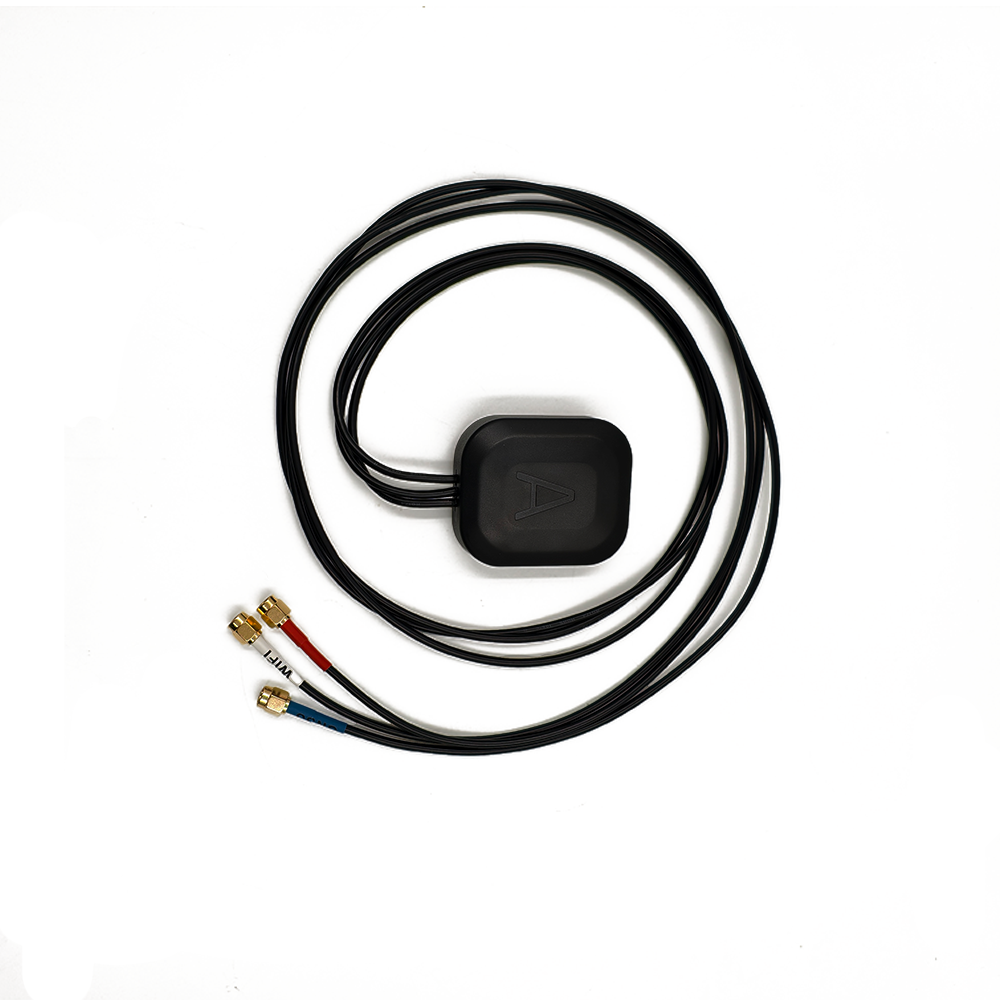What is a Multi - frequency GNSS Antenna?
A multi - frequency GNSS antenna is a specialized antenna designed to receive and process signals from multiple frequency bands of global navigation satellite systems. These systems include well - known ones like GPS (Global Positioning System) from the United States, GLONASS from Russia, Galileo from the European Union, BeiDou from China, and other regional systems. Each of these constellations transmits signals on multiple frequency bands. For example, GPS uses L1 (1575.42 MHz), L2 (1227.60 MHz), and L5 (1176.45 MHz) bands; Galileo uses E1, E5a, E5b, and E6 bands.
A multi - frequency GNSS antenna can simultaneously capture signals from two or more of these bands. By combining data from different frequencies, the antenna enables more accurate and reliable positioning. This is in contrast to single - frequency antennas, which are limited to a single band and thus more susceptible to various errors that degrade positioning performance.
Working Principles of Multi - frequency GNSS Antennas
Signal Reception Across Multiple Bands
The core functionality of a multi - frequency GNSS antenna lies in its ability to receive signals from multiple frequency bands. Each frequency band carries unique information, and by processing these signals together, the antenna can leverage the strengths of each band to enhance overall performance.
For instance, the L1 band (used by GPS, Galileo, and BeiDou) is widely used for civilian applications but is more prone to ionospheric delays. The L2 and L5 bands, on the other hand, have different characteristics that make them better at mitigating such delays. A multi - frequency antenna can receive signals from L1 and L5 bands, and by comparing the two, it can calculate and correct for ionospheric errors more effectively.
Error Mitigation Through Frequency Diversity
One of the key principles behind multi - frequency GNSS antennas is frequency diversity. Different sources of error, such as ionospheric and tropospheric delays, affect signals of different frequencies in distinct ways. By analyzing the differences between signals received at multiple frequencies, the antenna's associated receiver can model and remove these errors.
Ionospheric delay, caused by the interaction of satellite signals with charged particles in the Earth's ionosphere, is a major source of positioning error. The delay varies with the frequency of the signal. Using two frequencies, the receiver can use a mathematical model to compute the ionospheric delay and subtract it from the position calculation. This is not possible with a single - frequency antenna, which must rely on less accurate empirical models to estimate the delay.
Similarly, tropospheric delays, caused by the Earth's atmosphere, can be better modeled using multi - frequency data, further improving accuracy.
Integration with Multiple Constellations
Multi - frequency GNSS antennas are often designed to work with multiple satellite constellations. By accessing signals from GPS, GLONASS, Galileo, and BeiDou simultaneously, the antenna increases the number of available satellites. This increased satellite visibility enhances positioning reliability, especially in environments where satellite signals are obstructed, such as urban canyons or dense forests. With more satellites in view, the receiver has more data points to calculate the position, reducing the impact of individual satellite errors.
Key Components of Multi - frequency GNSS Antennas
Radiating Element
The radiating element is the part of the antenna that captures the incoming GNSS signals. In multi - frequency antennas, the radiating element is designed to be responsive to multiple frequency bands. This requires careful engineering of the element's size, shape, and material. For example, the element may be a patch antenna with a multi - layered structure or a complex geometry that allows it to resonate at different frequencies. The goal is to ensure efficient reception of signals across all targeted bands.
Feed Network
The feed network is responsible for transferring the received signals from the radiating element to the receiver. In multi - frequency antennas, the feed network must handle multiple frequency bands without significant interference or signal loss. It may include filters to separate different frequencies, ensuring that each band's signal is processed correctly. The feed network is designed to maintain impedance matching across all frequencies, maximizing power transfer and minimizing signal reflections.
Low - Noise Amplifier (LNA)
Since GNSS signals are very weak when they reach the Earth's surface, a low - noise amplifier (LNA) is a critical component of multi - frequency GNSS antennas. The LNA amplifies the weak signals received by the radiating element while adding as little noise as possible. In multi - frequency antennas, the LNA is often designed to operate across the multiple frequency bands, ensuring that signals from each band are amplified appropriately. Some advanced antennas may have separate LNAs for different bands to optimize performance for each frequency.
Filtering Components
To prevent interference from unwanted signals (such as those from other wireless devices or radio transmitters), multi - frequency GNSS antennas include filtering components. These filters are designed to pass only the desired GNSS frequencies and block out others. For example, a band - pass filter for the L1 band will allow signals around 1575.42 MHz to pass through while attenuating signals outside this range. Multiple filters are used in multi - frequency antennas to handle each targeted band, ensuring that the received signals are clean and free from interference.
Ground Plane
The ground plane is a conductive surface (usually a metal plate) that is placed beneath the radiating element. It helps to shape the antenna's radiation pattern, improving the efficiency of signal reception. In multi - frequency antennas, the ground plane is designed to work with the radiating element across all frequency bands, ensuring consistent performance. The size and design of the ground plane can affect the antenna's gain and directivity, so it is carefully optimized during the antenna's development.
Advantages of Multi - frequency GNSS Antennas
Improved Positioning Accuracy
The most significant advantage of multi - frequency GNSS antennas is their ability to provide higher positioning accuracy compared to single - frequency antennas. By using multiple frequencies, they can effectively mitigate ionospheric and tropospheric errors, which are major sources of inaccuracy. For example, in open - sky conditions, a single - frequency antenna may provide positioning accuracy of a few meters, while a multi - frequency antenna can achieve accuracy of less than a meter, and in some cases, centimeter - level accuracy when combined with RTK (Real - Time Kinematic) technology.
Enhanced Reliability in Challenging Environments
Multi - frequency GNSS antennas perform better in challenging environments such as urban canyons, dense forests, and areas with significant electromagnetic interference. In urban canyons, where buildings block and reflect satellite signals, multi - frequency antennas can use signals from different bands to identify and reduce the impact of multipath interference (where signals reflect off surfaces before reaching the antenna). The increased number of available satellites from multiple constellations also helps maintain a stable position fix, even when some satellites are blocked.
Better Resistance to Interference and Jamming
Interference and jamming are growing concerns in GNSS applications. Multi - frequency GNSS antennas are more resistant to these threats because they can switch to alternative frequency bands if one band is jammed or interfered with. For example, if the L1 band (a common target for jamming) is disrupted, a multi - frequency antenna can rely on signals from the L2 or L5 bands to maintain positioning. This redundancy makes multi - frequency antennas more robust in critical applications such as aviation and military navigation.
Faster Signal Acquisition and Tracking
Multi - frequency GNSS antennas can acquire and track satellite signals more quickly than single - frequency antennas. With access to multiple bands, the receiver can lock onto signals from more satellites in a shorter time. This is particularly useful in applications where rapid positioning is essential, such as search and rescue operations or autonomous vehicle navigation. Once locked, the antenna can maintain tracking more reliably, even in dynamic environments where satellite visibility changes rapidly.
Applications of Multi - frequency GNSS Antennas
Precision Agriculture
In precision agriculture, multi - frequency GNSS antennas are used to guide farm machinery with high accuracy. Farmers can use these antennas in tractors, harvesters, and drones to perform tasks such as planting, fertilizing, and harvesting with precise row spacing and depth. This reduces waste, improves crop yields, and minimizes the use of fertilizers and pesticides. The high accuracy of multi - frequency antennas ensures that machinery follows predefined paths with minimal deviation, even in rural areas where satellite visibility may be partially obstructed by trees or terrain.
Surveying and Mapping
Surveying and mapping require highly accurate positioning data to create detailed topographic maps, boundary surveys, and construction site layouts. Multi - frequency GNSS antennas are essential tools in this field, as they can provide centimeter - level accuracy when combined with RTK or PPP (Precise Point Positioning) technology. Surveyors use handheld or mounted receivers with multi - frequency antennas to collect data quickly and efficiently, reducing the time and cost of surveying projects. The ability to work in challenging environments, such as urban areas or dense vegetation, makes multi - frequency antennas invaluable for modern surveying.
Aviation and Aerospace
In aviation, reliable and accurate navigation is critical for flight safety. Multi - frequency GNSS antennas are used in aircraft for en - route navigation, approach, and landing. They provide precise positioning information that, when combined with other avionics systems, ensures that aircraft stay on course and avoid collisions. The resistance to interference and jamming is particularly important in aviation, where any disruption to GNSS signals could have catastrophic consequences. In aerospace, multi - frequency antennas are used in satellites and space vehicles for orbit determination and navigation, where high accuracy is essential for mission success.
Autonomous Vehicles
Autonomous vehicles, including self - driving cars, trucks, and drones, rely on GNSS for positioning and navigation. Multi - frequency GNSS antennas provide the high accuracy and reliability needed for these vehicles to operate safely. They enable precise lane - keeping, obstacle avoidance, and route following, even in complex urban environments. By combining data from multiple frequency bands and constellations, the antennas ensure that the vehicle's positioning system remains robust, even when some signals are blocked or disrupted. This is crucial for building public trust in autonomous technology and ensuring its widespread adoption.
Marine Navigation
Marine navigation requires accurate positioning to avoid collisions, navigate through narrow waterways, and reach destinations safely. Multi - frequency GNSS antennas are used on ships, boats, and other marine vessels to provide reliable positioning data. They perform well in harsh marine environments, where saltwater, humidity, and vibration can affect equipment performance. The ability to receive signals from multiple constellations ensures that vessels maintain a position fix even in remote ocean areas where satellite visibility may be limited. Multi - frequency antennas also help in coastal mapping and hydrographic surveys, where accurate positioning is essential for creating nautical charts.
Disaster Response and Emergency Services
In disaster response and emergency services, rapid and accurate positioning is vital for locating victims, coordinating rescue efforts, and assessing damage. Multi - frequency GNSS antennas are used in emergency vehicles, drones, and handheld devices to provide real - time location data. They can operate in disaster - affected areas where infrastructure is damaged and satellite signals may be disrupted, ensuring that rescuers can navigate safely and efficiently. For example, in the aftermath of an earthquake or flood, multi - frequency antennas help emergency teams reach affected areas quickly, potentially saving lives.
Factors Affecting Performance
Antenna Design and Quality
The design and quality of the multi - frequency GNSS antenna have a significant impact on its performance. A well - designed antenna with high - quality components (such as low - loss materials, efficient LNAs, and precise filters) will provide better signal reception, lower noise, and improved frequency response. Poorly designed antennas may suffer from signal loss, cross - band interference, or inconsistent performance across different frequency bands.
Environmental Conditions
Environmental conditions such as rain, snow, fog, and extreme temperatures can affect the performance of multi - frequency GNSS antennas. Heavy rain or snow can attenuate satellite signals, reducing their strength when they reach the antenna. Extreme temperatures can cause the antenna's components to expand or contract, altering its electrical properties and resonant frequencies. However, multi - frequency antennas are often designed to withstand harsh environments, with rugged enclosures and weather - resistant materials.
Signal Interference and Jamming
Despite their better resistance to interference, multi - frequency GNSS antennas are still susceptible to strong jamming signals or high levels of electromagnetic interference (EMI). Jamming devices can transmit signals on GNSS frequencies, overwhelming the satellite signals and disrupting positioning. EMI from other electronic devices, such as radios, radars, or power lines, can also interfere with GNSS signals. To mitigate this, multi - frequency antennas may include advanced filtering technologies or anti - jamming algorithms.
Satellite Availability and Geometry
The performance of multi - frequency GNSS antennas depends on the availability and geometry of the satellites in view. A larger number of satellites with good geometric distribution (spread out across the sky) improves positioning accuracy. In areas where satellite visibility is limited (such as deep urban canyons or indoors), even multi - frequency antennas may struggle to maintain high accuracy. However, their ability to access multiple constellations and bands increases the chances of having enough satellites in view.
Future Trends and Developments
-
Integration with 5G and IoT
The integration of multi - frequency GNSS antennas with 5G networks and the Internet of Things (IoT) is a growing trend. 5G's high data rates and low latency will enable faster processing and transmission of GNSS data, enhancing the performance of location - based services. In IoT applications, multi - frequency antennas will provide accurate positioning for a wide range of devices, from smart city sensors to asset tracking systems. This integration will enable new applications such as real - time traffic management, smart agriculture monitoring, and precision logistics.
Miniaturization and Low - Power Design
As technology advances, multi - frequency GNSS antennas are becoming smaller and more power - efficient. This allows them to be integrated into smaller devices such as wearables, smartphones, and small drones. Miniaturization is achieved through advancements in antenna design, such as the use of metamaterials or printed circuit board (PCB) technology, which reduce the size of the radiating element without sacrificing performance. Low - power designs are essential for battery - powered devices, extending their operational life and making them more practical for field use.
Advanced Anti - jamming Technologies
With the increasing threat of GNSS jamming and spoofing, future multi - frequency antennas will incorporate more advanced anti - jamming technologies. These may include adaptive beamforming, which focuses the antenna's reception on the desired satellites while nulling out jamming signals, and machine learning algorithms that can detect and mitigate spoofing attacks. These technologies will make multi - frequency antennas even more robust, ensuring reliable positioning in hostile environments.
Multi - band and Multi - constellation Optimization
Future multi - frequency GNSS antennas will be optimized to work with an even wider range of frequency bands and satellite constellations. As new GNSS constellations are deployed and existing ones are upgraded (such as the addition of new bands to GPS and Galileo), antennas will need to support these new frequencies. This will further improve positioning accuracy and reliability, as more data from different sources is available for processing. Optimization will also focus on reducing cross - band interference and improving signal - to - noise ratios across all bands.
Cost Reduction
Currently, multi - frequency GNSS antennas are more expensive than single - frequency ones, limiting their adoption in some consumer applications. However, as manufacturing techniques improve and demand increases, the cost of multi - frequency antennas is expected to decrease. This will make them more accessible for a wider range of applications, from consumer electronics such as smartphones and smartwatches to low - cost IoT devices. Lower costs will drive innovation and expand the use of high - precision positioning in everyday life.
Conclusion
-
Multi - frequency GNSS antennas have transformed the field of global navigation by providing higher accuracy, reliability, and robustness than single - frequency antennas. Their ability to receive signals from multiple frequency bands and satellite constellations enables them to mitigate errors, resist interference, and perform well in challenging environments. From precision agriculture and surveying to aviation and autonomous vehicles, multi - frequency antennas are playing a crucial role in a wide range of applications, driving efficiency, safety, and innovation.
As technology continues to advance, multi - frequency GNSS antennas will become even more capable. Integration with 5G and IoT, miniaturization, advanced anti - jamming technologies, and cost reduction will expand their use and enable new applications. With their ability to provide precise positioning in an increasingly connected world, multi - frequency GNSS antennas are set to remain at the forefront of navigation technology, shaping the future of how we navigate, map, and interact with our environment.




































































 Language
Language
 En
En Cn
Cn Korean
Korean

 Home >
Home > 








 18665803017 (Macro)
18665803017 (Macro)













